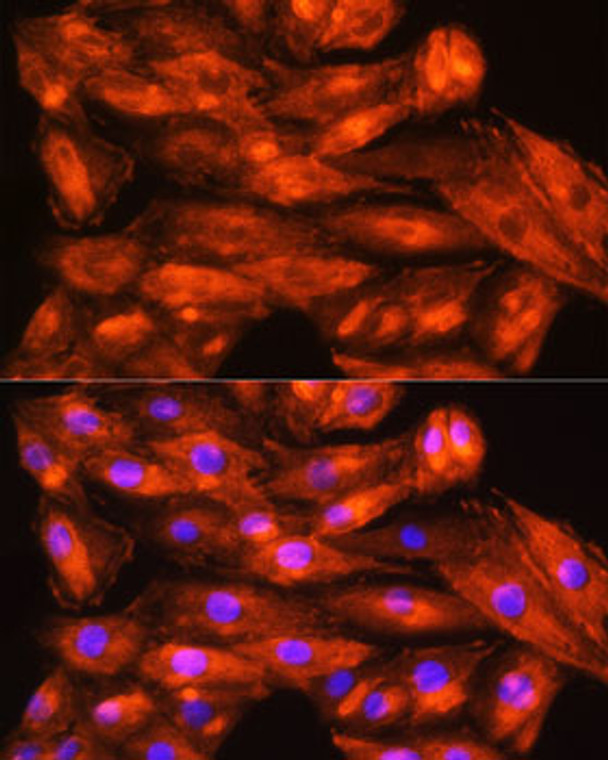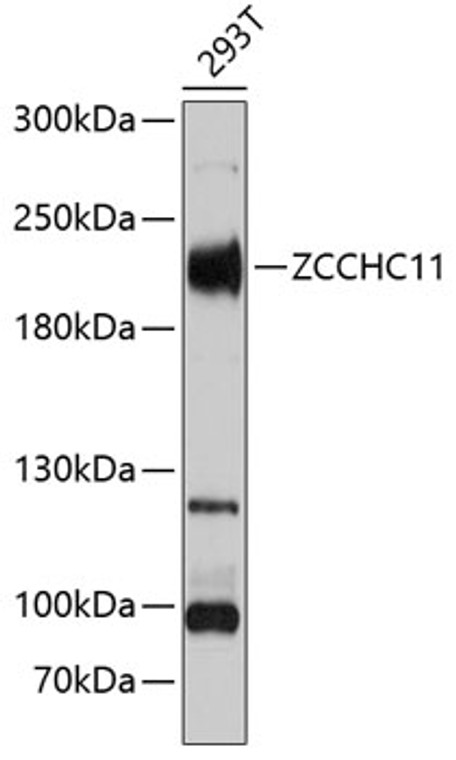| Host: |
Rabbit |
| Applications: |
WB/IF |
| Reactivity: |
Human/Mouse/Rat |
| Note: |
STRICTLY FOR FURTHER SCIENTIFIC RESEARCH USE ONLY (RUO). MUST NOT TO BE USED IN DIAGNOSTIC OR THERAPEUTIC APPLICATIONS. |
| Short Description: |
Rabbit polyclonal antibody anti-ZCCHC11 (1-290) is suitable for use in Western Blot and Immunofluorescence research applications. |
| Clonality: |
Polyclonal |
| Conjugation: |
Unconjugated |
| Isotype: |
IgG |
| Formulation: |
PBS with 0.01% Thimerosal, 50% Glycerol, pH7.3. |
| Purification: |
Affinity purification |
| Dilution Range: |
WB 1:500-1:1000IF/ICC 1:50-1:200 |
| Storage Instruction: |
Store at-20°C for up to 1 year from the date of receipt, and avoid repeat freeze-thaw cycles. |
| Gene Symbol: |
TUT4 |
| Gene ID: |
23318 |
| Uniprot ID: |
TUT4_HUMAN |
| Immunogen Region: |
1-290 |
| Immunogen: |
Recombinant fusion protein containing a sequence corresponding to amino acids 1-290 of human ZCCHC11 (NP_001009881.1). |
| Immunogen Sequence: |
MEESKTLKSENHEPKKNVIC EESKAVQVIGNQTLKARNDK SVKEIENSSPNRNSSKKNKQ NDICIEKTEVKSCKVNAANL PGPKDLGLVLRDQSHCKAKK FPNSPVKAEKATISQAKSEK ATSLQAKAEKSPKSPNSVKA EKASSYQMKSEKVPSSPAEA EKGPSLLLKDMRQKTELQQI GKKIPSSFTSVDKVNIEAVG GEKCALQNSPRSQKQQTCTD NTGDSDDSASGIEDVSDDL |
| Function | Uridylyltransferase that mediates the terminal uridylation of mRNAs with short (less than 25 nucleotides) poly(A) tails, hence facilitating global mRNA decay. Essential for both oocyte maturation and fertility. Through 3' terminal uridylation of mRNA, sculpts, with TUT7, the maternal transcriptome by eliminating transcripts during oocyte growth. Involved in microRNA (miRNA)-induced gene silencing through uridylation of deadenylated miRNA targets. Also functions as an integral regulator of microRNA biogenesis using 3 different uridylation mechanisms. Acts as a suppressor of miRNA biogenesis by mediating the terminal uridylation of some miRNA precursors, including that of let-7 (pre-let-7), miR107, miR-143 and miR-200c. Uridylated miRNAs are not processed by Dicer and undergo degradation. Degradation of pre-let-7 contributes to the maintenance of embryonic stem (ES) cell pluripotency. Also catalyzes the 3' uridylation of miR-26A, a miRNA that targets IL6 transcript. This abrogates the silencing of IL6 transcript, hence promoting cytokine expression. In the absence of LIN28A, TUT7 and TUT4 monouridylate group II pre-miRNAs, which includes most of pre-let7 members, that shapes an optimal 3' end overhang for efficient processing. Adds oligo-U tails to truncated pre-miRNAS with a 5' overhang which may promote rapid degradation of non-functional pre-miRNA species. May also suppress Toll-like receptor-induced NF-kappa-B activation via binding to T2BP. Does not play a role in replication-dependent histone mRNA degradation. Due to functional redundancy between TUT4 and TUT7, the identification of the specific role of each of these proteins is difficult. TUT4 and TUT7 restrict retrotransposition of long interspersed element-1 (LINE-1) in cooperation with MOV10 counteracting the RNA chaperonne activity of L1RE1. TUT7 uridylates LINE-1 mRNAs in the cytoplasm which inhibits initiation of reverse transcription once in the nucleus, whereas uridylation by TUT4 destabilizes mRNAs in cytoplasmic ribonucleoprotein granules. |
| Protein Name | Terminal Uridylyltransferase 4Tutase 4Zinc Finger Cchc Domain-Containing Protein 11 |
| Database Links | Reactome: R-HSA-429947 |
| Cellular Localisation | NucleusCytoplasmCytoplasmic Ribonucleoprotein GranuleMainly CytoplasmicTranslocates Into The Cytoplasm Following Treatment Of The Cell With LpsCo-Enriched In Cytoplasmic Foci With Mov10 |
| Alternative Antibody Names | Anti-Terminal Uridylyltransferase 4 antibodyAnti-Tutase 4 antibodyAnti-Zinc Finger Cchc Domain-Containing Protein 11 antibodyAnti-TUT4 antibodyAnti-KIAA0191 antibodyAnti-ZCCHC11 antibody |
Information sourced from Uniprot.org
12 months for antibodies. 6 months for ELISA Kits. Please see website T&Cs for further guidance










![Western blot analysis of lysates from wild type (WT) and MSH6 knockout (KO) HeLa cells, using [KO Validated] MSH6 Rabbit polyclonal antibody (STJ119980) at 1:500 dilution. Secondary antibody: HRP Goat Anti-Rabbit IgG (H+L) (STJS000856) at 1:10000 dilution. Lysates/proteins: 25 Mu g per lane. Blocking buffer: 3% nonfat dry milk in TBST. Detection: ECL Basic Kit. Exposure time: 1min. Western blot analysis of lysates from wild type (WT) and MSH6 knockout (KO) HeLa cells, using [KO Validated] MSH6 Rabbit polyclonal antibody (STJ119980) at 1:500 dilution. Secondary antibody: HRP Goat Anti-Rabbit IgG (H+L) (STJS000856) at 1:10000 dilution. Lysates/proteins: 25 Mu g per lane. Blocking buffer: 3% nonfat dry milk in TBST. Detection: ECL Basic Kit. Exposure time: 1min.](https://cdn11.bigcommerce.com/s-zso2xnchw9/images/stencil/300x300/products/98765/382817/STJ119980_1__09948.1713151312.jpg?c=1)